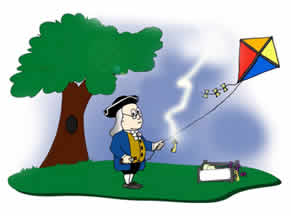The Leyden Jar is the first known
capacitor used to store an electrical charge. The jar was made of glass
and lined with metal foil, both inside and outside of the jar. The jar
was then fill half way with water and a chain or steel rod was inserted
into the top of the jar. Low conductivity material (cork) was used to
hold the metal chain/rod in place. The water and foil inside the jar
held the positively charged ions and the outside foil retained the
negatively charged ions.
The results from the Leyden Jar
experiments caught the eye of Benjamin Franklin who took the use of electricity one step
farther. With the ability to store an electric charge until a needed t ime, Ben conducted his own experiment
in 1750 (5 years after the
results from the
Leyden Jar were discovered). He began with a small cylinder
filled with black powder which was connected to the rod of
the Leyden Jar with a wire. Another wire came out of the other end of the black
powder-filled cap to continue the electrical circuit. As it turns out, the
electrical current running through from the jar and through the wire
had the strength to 'leap' through the gap in the wire by arcing from
wire to the next. The energy within the electric current ignited the
black powder, making it the first recorded blasting cap.
ime, Ben conducted his own experiment
in 1750 (5 years after the
results from the
Leyden Jar were discovered). He began with a small cylinder
filled with black powder which was connected to the rod of
the Leyden Jar with a wire. Another wire came out of the other end of the black
powder-filled cap to continue the electrical circuit. As it turns out, the
electrical current running through from the jar and through the wire
had the strength to 'leap' through the gap in the wire by arcing from
wire to the next. The energy within the electric current ignited the
black powder, making it the first recorded blasting cap.
It
was not until 70 years later when a man, Robert Hare, took Ben's
findings and created his own blasting cap. Rather than having wires
leading right into black powder, Robert created a mixture that we now
know as a Pyrotechnic. However, its use was insignificant
due to the fact that there was not much difference between Robert and
Benjamin's design.
In 1864, Alfred Nobel was in a quary
demonstrating his new invention of dynamite. Using Robert Hare's pyrotechnic
fuse for an ignition on a stick of dynamite, Alfred lit the fuse with a
match and blasted his way into history. This was a break through as
settlers struck gold while marching toward America's west coast.


 ime, Ben conducted his own experiment
in 1750 (5 years after the
results from the
Leyden Jar were discovered). He began with a small cylinder
filled with black powder which was connected to the rod of
the Leyden Jar with a wire. Another wire came out of the other end of the black
powder-filled cap to continue the electrical circuit. As it turns out, the
electrical current running through from the jar and through the wire
had the strength to 'leap' through the gap in the wire by arcing from
wire to the next. The energy within the electric current ignited the
black powder, making it the first recorded blasting cap.
ime, Ben conducted his own experiment
in 1750 (5 years after the
results from the
Leyden Jar were discovered). He began with a small cylinder
filled with black powder which was connected to the rod of
the Leyden Jar with a wire. Another wire came out of the other end of the black
powder-filled cap to continue the electrical circuit. As it turns out, the
electrical current running through from the jar and through the wire
had the strength to 'leap' through the gap in the wire by arcing from
wire to the next. The energy within the electric current ignited the
black powder, making it the first recorded blasting cap.